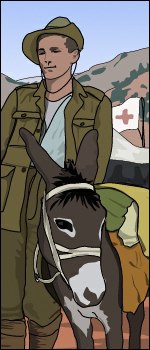John Simpson Kirkpatrick - the Man with the Donkey
Created | Updated Nov 6, 2006

At the end of 1914, the First World War was a war on three Fronts. Britain and France held the Western Front and Russia the Eastern. The entry of Turkey into the war threatened Britain's Empire in the Middle East and Russia's southern flank. The invasion of Turkey at a place the British called Gallipoli was a daring plan to secure the Middle East and force the Ottoman Empire to sue for peace. A mixed force of colonial and regular British troops of the Army and Navy landed and fought the Turks. It failed in its objectives, yet it is remembered as the Australia and New Zealand Army Corps' first major campaign. The ANZACs arrived as an untried but promising force and left it as a fighting force to be reckoned with.
There are many stories of bravery and of service to comrades that emerged from Gallipoli both during and after the event. However, there was one man who was remembered by ANZAC troops who was never awarded a decoration - John Simpson Kirkpatrick - the Man with the Donkey.
John Simpson Kirkpatrick
Jack was born in South Shields, County Durham (now Tyne and Wear) in 1892. He spent his childhood there, helping as a 'donkey lad' on the beach and delivering milk. After his father's death in 1909, he went to sea, working a number of ships before ending up in Australia. Despite making attempts to settle, he ended up back at sea until he landed at Perth in 1914 and learned of the start of hostilities against Germany, later called the 'Great War'. He signed up as plain John Simpson with the Australian Imperial Force (AIF) and became a stretcher-bearer with the 3rd Australian Field Ambulance.
After training in Egypt and on the island of Lemnos, the Corps landed at Gallipoli on 25 April, 1915. The Field Ambulance were trained to remove battlefield casualties and they started at once, removing the dead and wounded from the boats that were to carry them to shore and cleared all the casualties from the landing within 24 hours. Things did not go as planned and, due to a lack of stretchers and an overstretched organisation, Jack and his mates found themselves carrying the wounded on their back.
At some point, Jack found a donkey wandering on the beach. Using a bandage as a bridle, he used the animal to carry the casualties to the beach while keeping them upright. He was eventually supported by an Indian Army artillery unit which supplied fodder and stabling for four donkeys which Jack used in rotation. He quickly gained a reputation for rescuing casualties from the Front.
It is often said that he went out into No-Man's Land to do this, but it seems unlikely, given the defensive nature of the positions. Nevertheless, the Front Line, such as it was, was constantly swept by machine gun and rifle fire and rescue under these conditions was no mean feat. He recovered 300 casualties in this way. It must also be borne in mind that, on the ANZAC sector, nowhere was safe from Turkish machine gun or artillery fire, even swimmers in the bay could become casualties.
He worked an 18-hour day, getting food where and when he could. He seems to have operated independently of the Field Ambulance, taking water up to the forward lines before collecting casualties. He had a charmed life, it was thought, as he managed to avoid personal injury. His Indian comrades called him Bahadur ('Bravest of the Brave'), but to the AIF troops he was 'The Man with the Donkey'.
His luck ran out on 19 May, 24 days after he landed. While evacuating a casualty to the beach, he was hit by a burst of machine gun fire and died almost immediately. The donkey continued to the beach with its cargo and a search was organised for Jack. The spot where he was killed was considered so dangerous; they waited until nightfall to recover his body. He was buried at Hell Spit and the grave marked with a cross marked simply 'John Simpson'. Such was his reputation that one of his mates continued using the donkeys. Thus was the legend born.
He was given a 'Mention in Dispatches', a minor award without a medal, and recommended for the Victoria Cross, but it was not accepted. Whatever the reasons for this, he remains a symbol of bravery and of sacrifice for others. There are six statues of 'The Man with the Donkey'. Five are in Australia, where he represents the courage and conviction of those first ANZAC volunteers who fought for Great Britain, and one other in South Shields, where they remember one of their sons.
Related Links
- A detailed and illustrated story of the Man with the Donkey.

